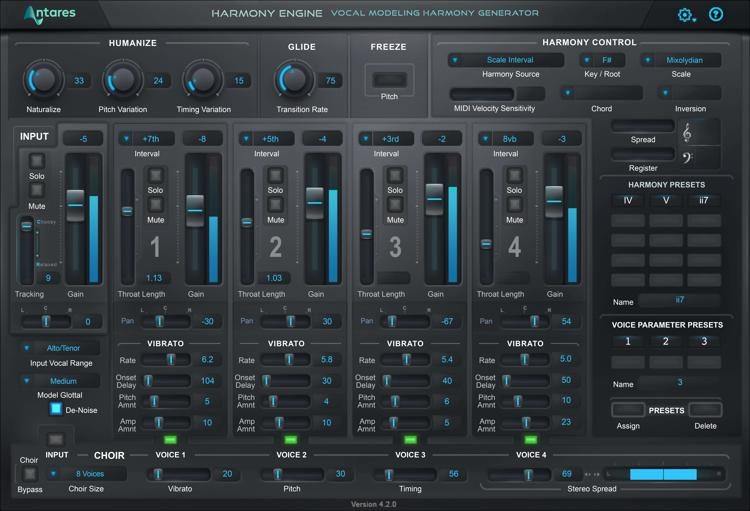Antares Harmony Engine isn’t new, but it’s gotten better and better over the years, making it worthy of a fresh review of features and specs. The company is well known for developing real-time plugins that make the lives of musicians, producers, and engineers much easier. Harmony Engine is a powerful tool able to take a monophonic input signal and turn it into a lush ensemble. If you struggle with harmonies or just want to expedite the process, this might be the tool for you.
What Is the Antares Harmony Engine?
Antares Harmony Engine is a vocal harmonizer plugin. It’s designed to provide advanced vocal processing and harmony generation capabilities for musicians, producers, and audio engineers.
The Harmony Engine offers various features to enhance vocal performances. It can automatically generate harmonies based on the lead vocal or monophonic instrument input, allowing users to create multi-part arrangements from a single source. Users can craft their own harmonies note by note, or let the plugin do the work for them.
How Does Harmony Engine Work?
The plugin analyzes the pitch and timing of the lead input and applies algorithms to generate harmonies. Harmony Engine also includes powerful pitch correction tools. It can correct the pitch of vocals in real-time, helping to ensure accurate intonation and smooth out any imperfections in the performance. The plugin provides controls to adjust the level of correction and the overall character of the vocal sound.
- RELATED: The Best Pitch Shifter VSTs
- RELATED: Antares Auto-Tune Unlimited Demo
In addition to its harmonization and pitch correction capabilities, Harmony Engine offers various other features such as formant shifting, throat modeling, and doubling effects. These tools allow users to further shape the vocal sound and achieve a desired tone or style.
Overall, Antares Harmony Engine is a versatile software plugin that empowers users to create rich, polished vocal arrangements with ease. It has found wide usage in music production, particularly in genres such as pop, R&B, and electronic music where vocal harmonies play a significant role.
Antares Harmony Engine Review
How Realistic Do the Harmonies Sound?
Frankly, it’s able to fool the average listener a lot of the time. Initially, there were doubts about Harmony Engine’s realism, but we’re talking over 15 years ago. Music production tools have only gotten better over time, and Antares is no exception. Their commitment to creating software that not only performs a unique task but does so convincingly is while they’re still at the top of the game all these years later.
Obviously, given the option to record real harmonies, you should go that route. But in a pinch or as a demoing tool, Harmony Engine does an adequate job of generating false harmonies that sound reasonably natural.
Interface & Ease-of-Use
Harmony Engine shares the same color scheme and similar layout as the rest of the Antares suite. If you’ve ever used Auto-Tune and gotten familiar with Antares products, then navigating Harmony Engine is no problem whatsoever. Despite the relative complexities of the plugin, namely due to having so many per-channel parameters, it’s easy to become accustomed after just a short time using it.
Effects & Versatility
Harmony Engine provides four voices and also gives users the ability to “choir-ize” them, adding additional unison voices to the mix. This lets you go from one lead vocal track to an entire ensemble instantly and automatically. The plugin also gives users the ability to shape and alter the timbre of the harmonies for additional versatility.
Where Does the Antares Harmony Engine Excel?
Harmony Engine excels at quickly producing dense vocal arrangements with minimal effort and user input. Again, this makes it ideal for production or writing demos, where you can easily audition how a harmony arrangement might sound in a certain section of a song. Depending on the genre and the song, it could easily make its way into the final production as well. We don’t intend to downplay its usability by calling it a “demo” tool or anything of the sort.
- RELATED: 25 Best Waves Plugins for Mixing
Under most circumstances, though, it likely wouldn’t be a replacement for layering real harmonies, given the option to do so. There’s still no substitute for a talented vocalist who’s able to write and perform their own arrangements. But as a standalone device to be used under specific circumstances, it’s an incredibly inventive plugin.
Conclusion: Is Harmony Engine Worth the Price?
Antares Harmony Engine is somewhat pricey at nearly $300 for a perpetual license. It’s quite a specific plugin, so it’s worth the price if you’re searching for software that performs this function. On the other hand, if it’s just something you want to experiment with, or something you may only use here or there, give it a go with the free trial, or take advantage of the Antares subscription bundle to package Harmony Engine with other plugins you may get more mileage from. All in all, it’s a powerful and impressive piece of software!
